NCAA Hockey Mid-Season Scoring Analysis
Jokke Nevalainen
2018-01-21
Welcome to the second edition of my Mid-Season Scoring Analysis. This time I’ll be focusing on college hockey, more specifically NCAA Division I. In my previous article named “CHL Mid-Season Scoring Analysis”, I explained the determining factors that I use when looking at scoring numbers from development leagues, so if you’re wondering what NHLe means or why I split players into groups based on their birth year, I suggest checking that article.
NCAA Division I is split into six conferences but unfortunately we have NHLe translation factors only available for four of those conferences, so we don’t know how good or bad the numbers from Atlantic Hockey Association and Western Collegiate Hockey Association conferences are. This is probably because there isn’t a high amount of players coming to the NHL from those two conferences, and when I went through the current scoring leaders from those two conferences, I didn’t see many familiar names there.
Even though the same NHLe translation factors that were used in the CHL article are also used in this article, I wouldn’t say the numbers are directly comparable between CHL and NCAA. The CHL has players between ages 16 and 20 while the NCAA has players between ages 18 and 24, so it’s more difficult for 18 and 19-year-olds to score big numbers in college hockey than it is in major junior.
Because there are less NHL prospects in college hockey compared to major junior, I decided to combine forwards and defensemen into one chart, and I also added some interesting free agents in there as well.
All data is taken from EliteProspects.com on January 18th, and points-per-game average is used. Let’s move on to the good stuff.
18-year-old players
Ryan Poehling is leading the list of 18-year-old players by a wide margin. He has an advantage against his competition as he already played college hockey last season as a 17-year-old but his numbers are very good regardless of that.
Behind him, we have two defensemen in Ian Mitchell and Michael Anderson, while Maxwell Gildon is not far behind those two. It’s quite impressive that these defensemen are right up there with the projected 2018 Top 10 pick Brady Tkachuk, and ahead of players like 2017 first round selections Shane Bowers and Joshua Norris – not to mention another projected 2018 Top 10 pick in Quinn Hughes. Similarly to what was noticed in the CHL article, I’m not impressed with the numbers of these projected top picks for the upcoming NHL draft. Their numbers are good but I would expect them to be better. But I wouldn’t be worried about any of the players on this chart because as previously mentioned, it’s very difficult to score in college hockey as an 18-year-old when pretty much everyone is older than you.
19-year-old players
I’m surprised to see so many undrafted players near the top of the chart of 19-year-old players. There were more undrafted players lower on the list but I didn’t want to clutter the chart, so I left them out of it. The common theme among the undrafted players is lack of size; Hugh McGing is 5-8, and Mitchell Lewandowski and Scott Perunovich (who impressed at the World Junior Championship) are 5-9. But with numbers like these, they probably deserve consideration for the 2018 NHL Entry Draft.
Speaking of smaller players, Patrick Harper is having another strong NCAA season. His size at 5-9 will always raise questions but the offensive talent is clearly there.
The Chicago Blackhawks had Mitchell high on the 18-year-old chart, and they have another defenseman near the top here in Chad Krys who surprisingly wasn’t selected to play at the World Junior Championship this year despite playing there a year ago.
I’m not impressed with the numbers that I’m seeing from Casey Mittelstadt who was selected as the Most Valuable Player at the 2018 World Junior Championship tournament. Anyone who watches him play can see the skills and talent level but it hasn’t translated to big offensive numbers so far in his career. Talking about World Junior standouts, I was also expecting to see better numbers from Cale Makar and Adam Fox but I’m sure there are reasons to their numbers.
Riley Tufte, Trent Frederic and Dante Fabbro are doing fine on this chart but as former first round selections, they are expected to be more than just fine.
20-year-old players
Henrik Borgström is leading the list, and he actually has the best NHLe value in the entire league. Other impressive drafted players from this list are Wade Allison, Troy Terry, Erik Foley and Tanner Laczynski. Terry might be a well-known name at this point with the 2017 World Junior Championship heroics and the 2018 Olympic team selection on his résumé but the other three may not be highly valued in your fantasy hockey league, so it might be a good idea to kick some tires or maybe add them from free agency if they’re available.
When we look at the undrafted players, we see some size concerns yet again; Nicholas Halloran and Colt Conrad are 5-10, Gordon Green is 5-8, and Robby Jackson is 5-9. But Halloran especially should be getting some NHL interest with these numbers, and 5-10 isn’t even small in today’s NHL.
Considering the strength of defensemen on the previous two charts, I’m surprised by the lack of high-end defensemen on this one.
21-year-old players
Adam Gaudette is leading the list of 21-year-olds by a wide margin but I’m also impressed with the numbers from Dylan Gambrell, Michael Eyssimont, Cooper Marody, Jake Evans and Louis Belpedio. Gaudette and Belpedio are having great seasons and should be owned in leagues with deep farm systems but I’d also keep an eye on the other four as they could turn pro soon either this year or the next.
Maxim Letunov is the biggest disappointment from this chart. He had a great first season but his numbers have gone down in both years since then.
Overall view of the entire league
Since there are only a few interesting players older than 21, I decided to combine all the top NHLe values from the league into one chart so that you can see the numbers for them but also compare them against younger players. Player’s age is mentioned inside the NHLe value bar. As added perspective, I also added the NHLe values from last year for a few well-known players. I have highlighted those values in orange color on the chart, and added their age from last season in there as well.
Borgström, Gaudette and Allison are really looking good in comparison here when they’re in the same group with older players like Dylan Sikura and David Pope.
Sikura, Pope, Evans and Belpedio could potentially follow the path we’ve seen from Kevin Hayes, Jimmy Vesey, Will Butcher and Alex Kerfoot, meaning they’re playing their fourth and final NCAA season now and could become unrestricted free agents after August 15th if they don’t sign a contract with the NHL team that drafted them. If they decide to do that, the hype machine will go into overdrive, so keep an eye on their situations as their trade value could go up in that case.
From the undrafted free agents, besides Halloran, Jimmy Schuldt draws my interest. He has good size at 6-1 and 205 lbs, he’s the Captain of his team, and he’s scoring over point per game this season. And yes, he’s a defenseman. Only 22 years old as well, so he’s not too old by any means. Two names I’ve often seen when reading about undrafted free agents are Daniel Brickley and Zach Whitecloud but they both play in the Western Collegiate Hockey Association conference, so that’s why you didn’t see their names on my charts – there are no NHLe translation factors available for that conference.
That’s all for now. Feel free to comment below. You can also find me on Twitter @JokkeNevalainen
LATEST PROFILE UPDATES
LATEST RADIO & DRAFTCASTS
9 Comments
Leave A Comment
You must be logged in to post a comment.


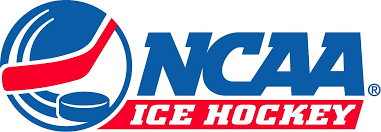
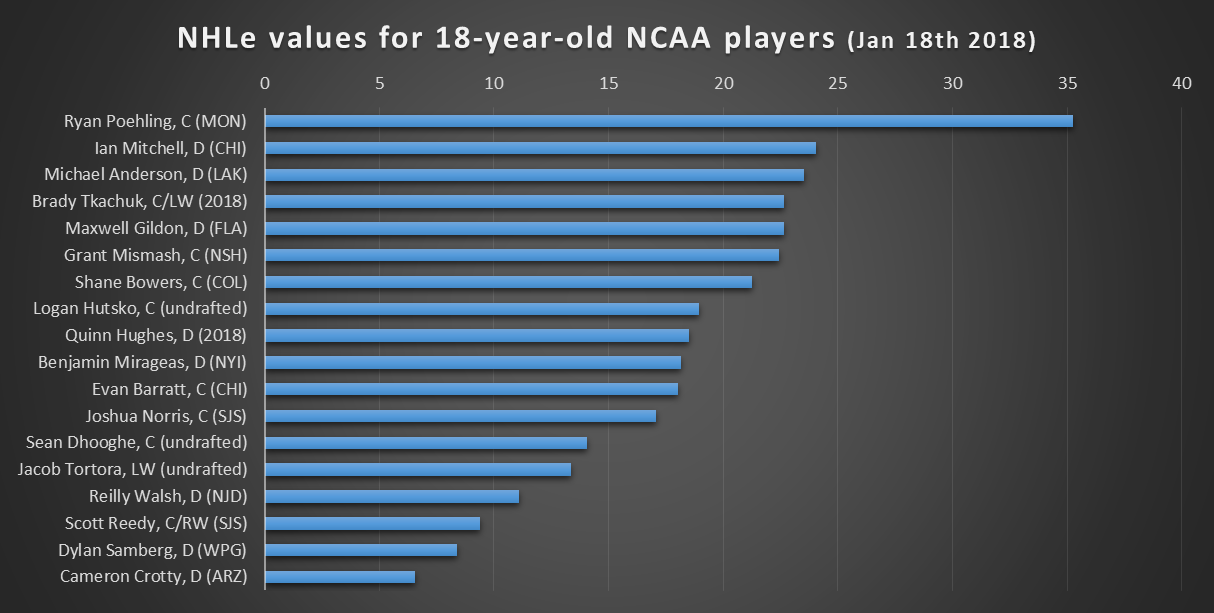
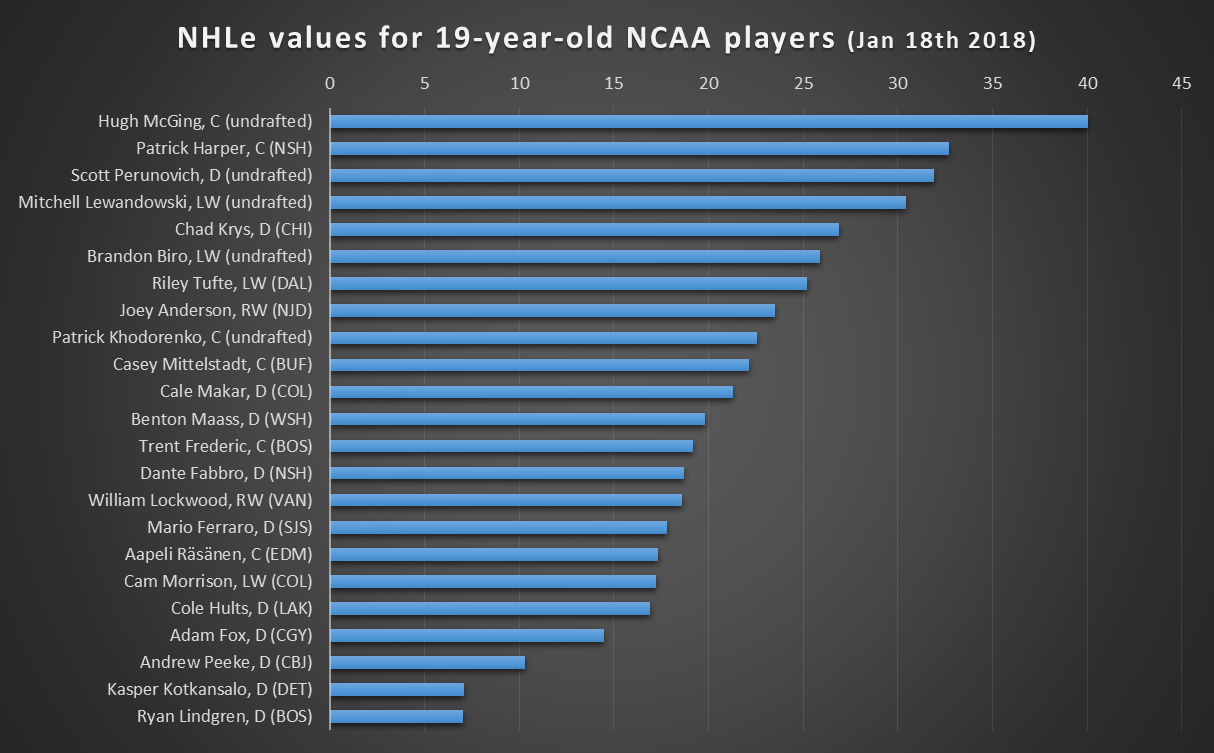
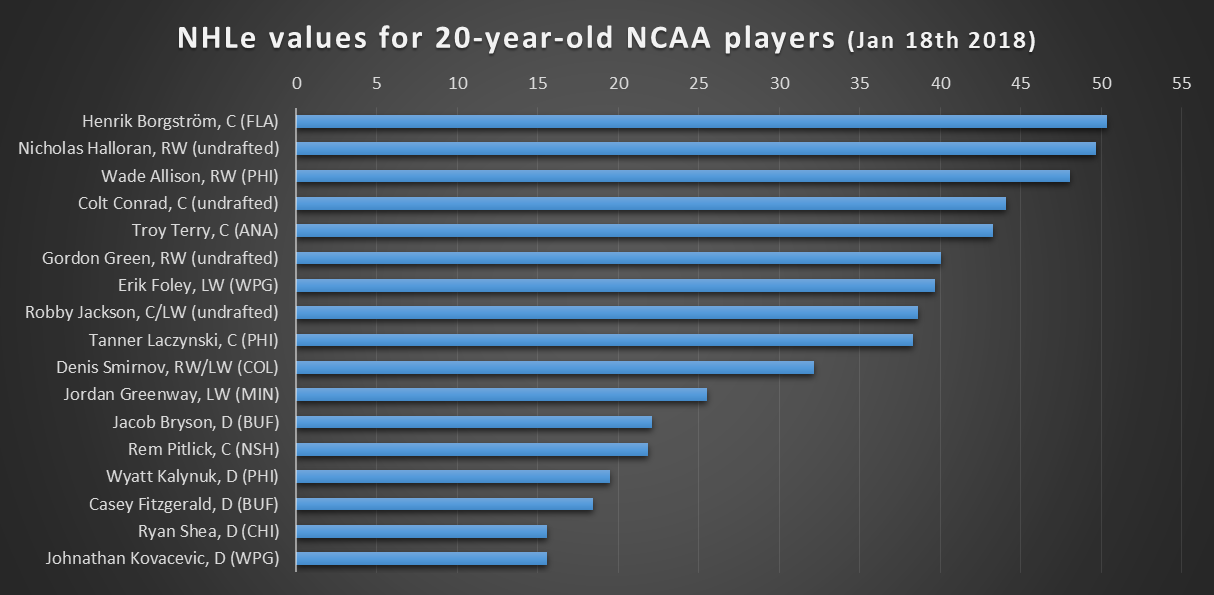
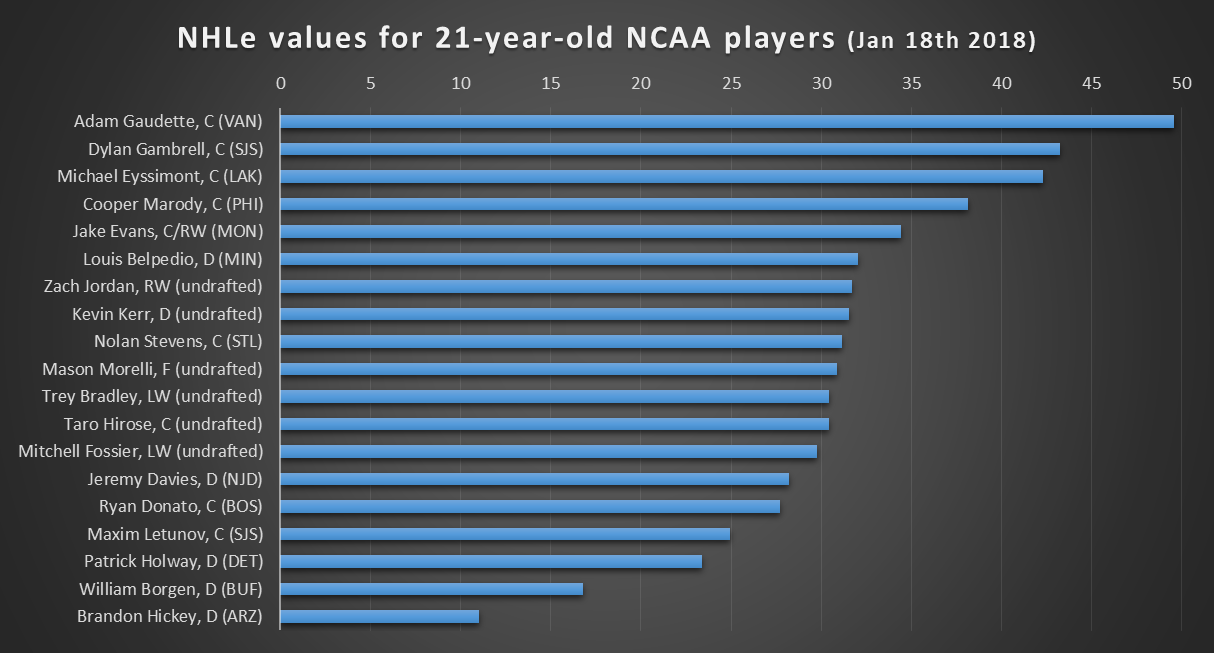
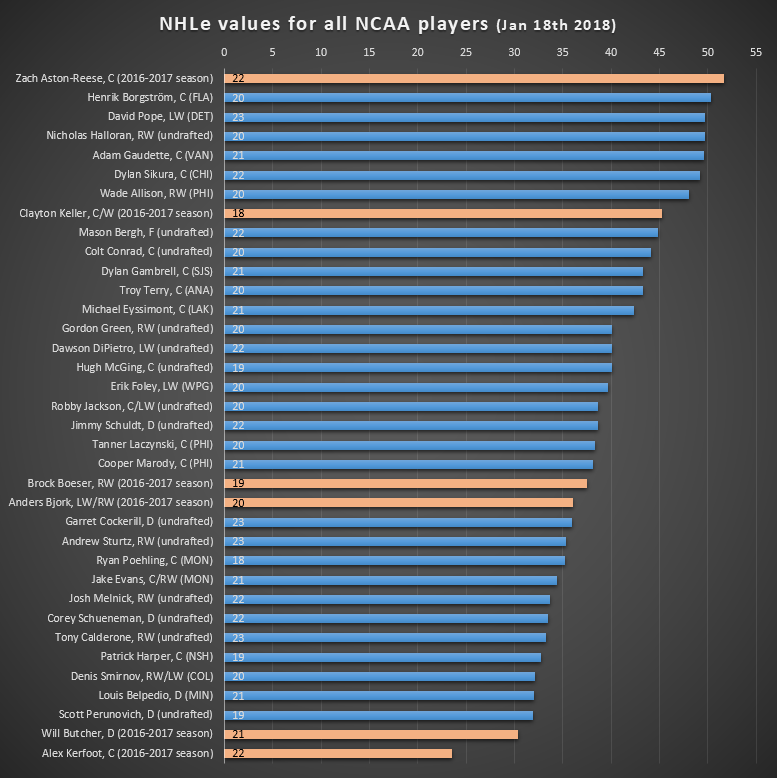
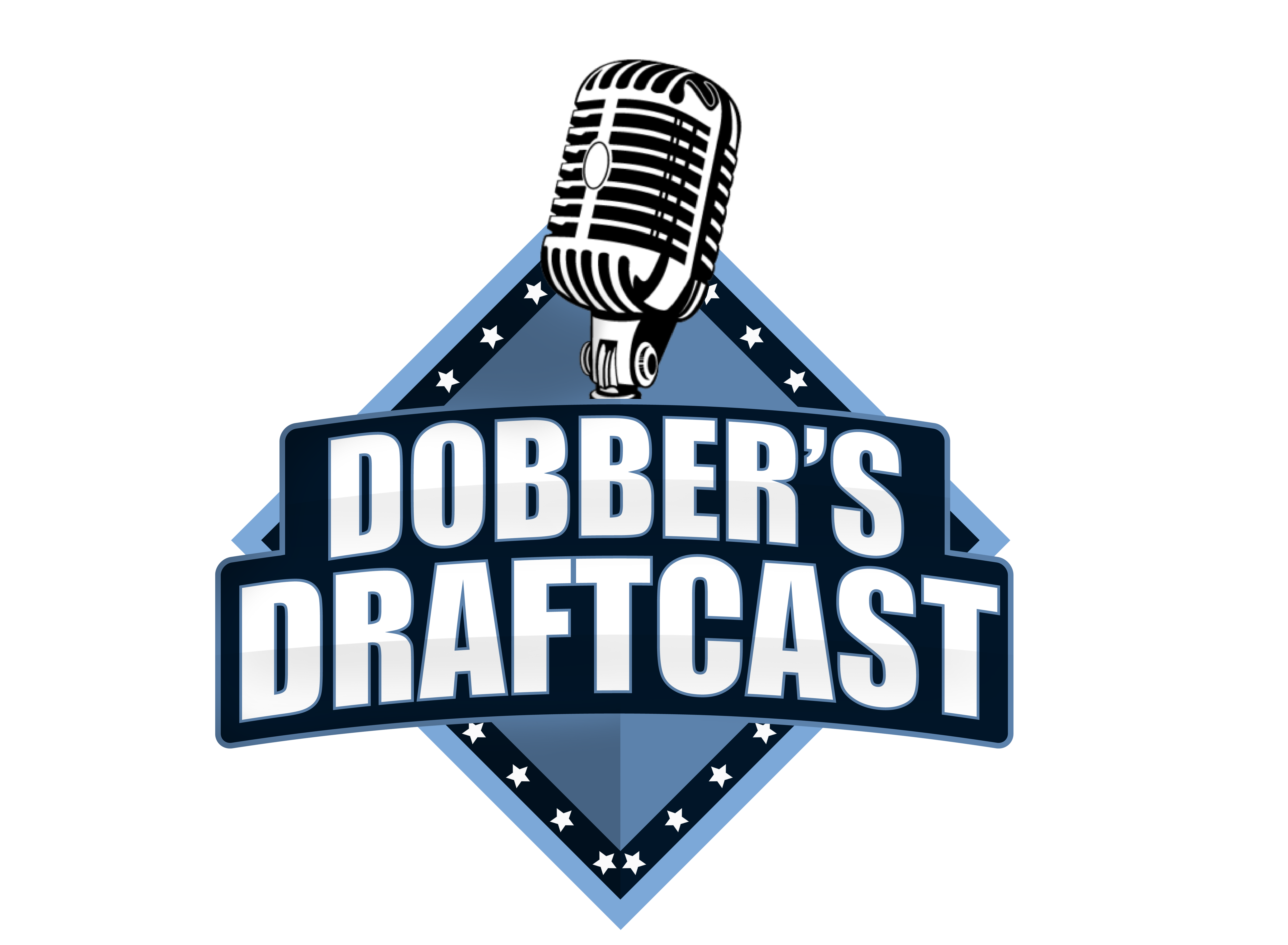
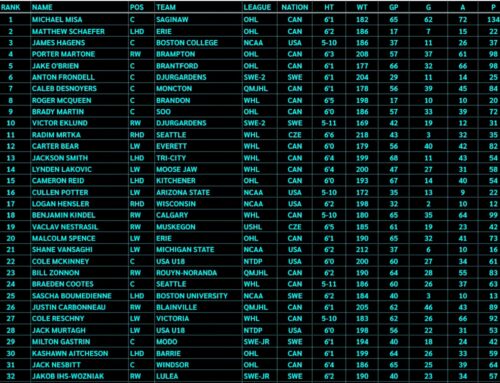
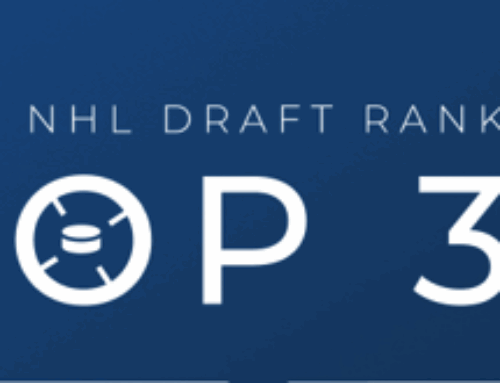
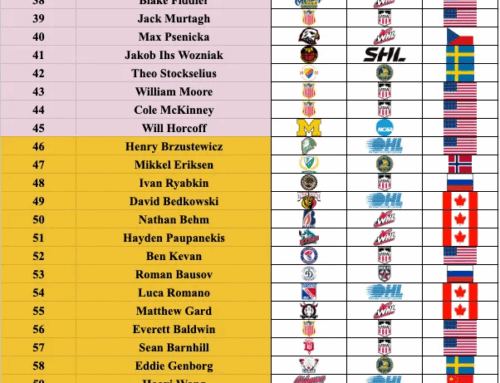
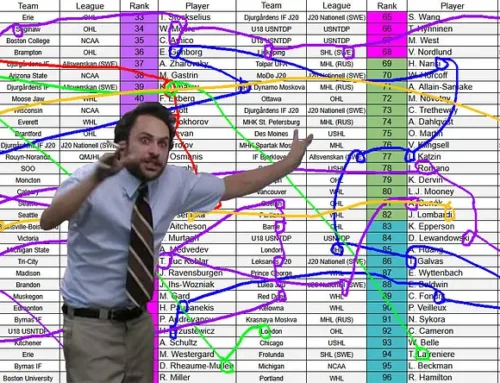
Thank you for these scoring analysis, Jokke! They’ve been very interesting.
Disappointed in Casey Mittelstadt? Lmfao. This is why numbers are for people who can’t properly evaluate talent with their own eyes. Casey Mittelstadt has been stellar as a freshman. Anyone who has actually watched even just one of his games would agree.
Try actually watching a game for once, instead of trying to back up your opinion with a fancy statistical formula that proves absolutely nothing.
There’s a reason why everyone who actually knows and watches hockey raves about the kid.
I’m curious if you read the second sentence I wrote about him? In case you didn’t, here’s what I wrote: “Anyone who watches him play can see the skills and talent level but it hasn’t translated to big offensive numbers so far in his career.”
He got you there, Tyler! “Try actually watching a game for once” is something you write after you “try actually reading the full context/article for once”! lol
Regardless, this is a fantasy-hockey site, so a player can have all the talent in the world. But if he doesn’t put up numbers, then he’s an anchor on fantasy teams. Fortunately, Mittelstadt put up huge WJC numbers and his NCAA numbers are starting to turn around too. But we knew it was coming because we tried “actually watching a game” ;)
I’m wondering why there’s no love for Alec Rauhauser ? The only D in the NCAA top 50 in scoring, a 22 year old sophomore and has good size ( likely benefiscal in the NHL ) 6’3″/220
I haven’t seen him but the WCHA where he plays is a weak conference, and also, 13 of Rauhauser’s 24 assists are secondary which is a high percentage. Secondary assists are often more about luck than skill, although there are definitely exceptions to that.
Regardless of all that, I think he’ll draw some NHL interest with those numbers. But those factors might explain why there’s not much talk about him.
A good point for sure. The NCAA is a difficult league to judge because of the differences between conferences, but it can’t always be accident. I think he’s older than most sophomores and that might account for some.
Your point about secondary assists isn’t inherently true at all. Strong break-outs by d-man often lead to secondary assists. Your point is more salient for forwards than for d-man.
You’re right about defensemen having more secondary assists than forwards just because of their position and role but 13/24 is still on the high side even for a defenseman. It’s not terrible but a bit higher than usual.